The Pampanito Amateur Radio Club call letters are NJ6VT. This call is very significant to the USS Pampanito as the submarine's old WWII radio call was NJVT.
USS PAMPANITO SS-383
USS PAMPANITO (SS 383) FACTS & FIGURES
LENGTH
311' 9"
FORWARD TORPEDO ROOM
This is a photo inside one of the torpedo tubes.
There are two engine rooms on the submarine. This photograph, (taken with available light), shows the two Fairbanks-Morse diesel engines in the forward engine room. (View, looking aft.) Two 10 cylinder, 1600 horsepower diesels can be seen, left and right sides of the photo. Each engine turns a large generator to produce electricity. This is used to charge batteries and to run the electric motors that drive the sub's two screws. The engines are only used when the sub is surfaced. Batteries are used while the boat is submerged.
This photograph shows the two Fairbanks-Morse diesel engines in the aft engine room. (View, looking forward.) These are 10 cylinder, 1600 horsepower diesels. Each engine turns a large generator to produce electricity which is used to charge batteries and to run the electric motors that drive the sub's two screws. The engines are only used when the sub is surfaced. Batteries are used while the boat is submerged.
This is the control room looking forward from the radio room passageway. The control room is the nerve center of the submarine. All systems on the boat can be controlled from this space.
RAL and RAK Receivers, the RAK mounted on the left has a frequency range of 15 to 600 kc. in six bands. The RAL mounted on the right has a frequency range of .3 to 23 Mc. in nine bands. Both receivers were used for ship-shore communications using CW, MCW, and voice.
This photo was taken on the main deck looking aft from the portside of the conning tower. You can see the portside longwire antenna that is used by the Amateur Radio station in the Pampanito's radio room. This antenna is 115 feet in length and is tuned by an automatic antenna tuner mounted at the feed point on the sub's bridge.
As you can see, the conning tower is a rather small space. Located above the control room, the conning tower contains the periscopes, sonar, radar, and torpedo data computer. There are two periscopes, the scope in the background is the attack scope. In the upper right corner of the photo is the torpedo status indicators . The aft torpedo firing button can be seen to the right in the white area near the torpedo status boards.
This is a photo of the alarm controls mounted on the forward periscope shaft housing in the control room. There is another identical set of controls positioned up in the conning tower. The various alarm controls are identified as follows;
The far left alarm, (Yellow), is the General Alarm. It is used to signal General Quarters / Battle Stations. It makes a Bong, Bong, Bong, bell type sound.
The middle alarm, (Red), is the Collision Alarm. Used to alert the crew of collision. It sounds like a whistle running from a low to a high pitch.
The right alarm, (Green), is the Dive Alarm. Signals prior to diving the boat. Sounds like the old Model A Ford AH-OOGAH horn.
This machine was used to encode and decode radio messages.
A rather tight space for the crew.
As you can see from this photograph, the after torpedo room is a plumbers' nightmare. there are four torpedo tubes. Eight torpedos are carried in the aft torpedo room. Four in the tubes and four more on special skids along the sides of the room. Sixteen more torpedos were carried in the forward torpedo room bringing the total torpedo complement of a Balao class submarine to twenty four. Each torpedo weights approximately 3200 pounds.
During her six WWII patrols, the USS Pampanito sank six Japanese ships and damaged four others, with a total of over 27,000 tons of enemy shipping sent to the bottom of the Pacific Ocean. Also located in the aft torpedo room is the aft escape trunk and several bunks for crew berthing.
Starting left and moving right is the 40mm anti-aircraft gun, SL radar antenna & mast, SJ radar antenna, periscope #2 (attack periscope), IFF antenna (with broom attached), Low Frequency loop antenna (below the IFF), periscope #1, ECM antenna (small horizontal pipe), K6DF (ham operator), and far right the 20mm machine gun.
There are two High Frequency longwires, (115 feet), mounted on each side of the conning tower, both stretching back to the aft antenna mount. The port-side longwire is used by the USS Pampanito Amateur Radio Club, NJ6VT.
This photo was taken from the forward torpedo room hatch looking aft. the 4" deck gun is in the foreground. the hills of Marin County can be seen in the sunset background. This picture was taken in July of 1996. The USS Pampanito is open daily to the public from 9 A.M. to 6 P.M., during the summer months the submarine stays open until 8 P.M.
This is the radio operator position in the USS Pampanito's radio room . . . not much space here, only enough for two persons. The operator is K6DF.
To the right side of the photo is the old WWII TBL-7 transmitter, and on the left side is an RAK-6 receiver. Behind the RAK (just barely seen) is the current Yaesu FT-890 tranceiver used on the amateur radio bands.
The USS Pampanito Amateur Radio Club's call sign is NJ6VT.
Looking into the radio room from the control room passageway. On the shelf from left to right,
On the top right side of the RAK-6 is the Yaesu FT-5100 amateur tranceiver, 144 MHz to 148 MHz, 50 watts, & 432 MHz to 450 MHz, 35 watts.
Looking up through the hatch from the storage space below the radio room. It's very hard to take a good photo of this transmitter as there is very little room here, even for a wide angle lens.
Now you know why they're called . . . "Boat Anchors"
This is the hatch just below the radio operator position in the radio room. Right below the radio room is a space for the storage of radio parts and supplies. The person coming up through the hatch is Dennis K6DF. Kind of a tight fit.
The USS Pampanito SS-383 came out of dry dock on Jan 29, 1999 and is back home at Pier 45 in San Francisco. She looks GREAT in her new paint!
The following photos were taken on the Pampanito's trip to Bay Ship and Yacht dry dock in Alameda, CA. Bay Ship and Yacht dry dock is located on the Alameda side of Oakland's inner harbor.
Deck crew singles up all lines for USS Pampanito's departure for dry dock.
Sea River Company tug MARE ISLAND backing the sub away from Pier 45.
Heading east and about to go under the S.F. Bay bridge.
Port to port pass with USCG Cutter Sherman in the channel near NAS Alameda.
Nosing the USS Pampanito into Bay Ship and Yacht dry dock.
USS Pampanito being pulled into dry dock by dry dock crew.
USS Pampanito in dry dock with a new coat of paint, ready to go back into the water.
This shows the size of this sub. That's me, K6DF, standing in the dry dock just below the sub's anchor. Hummmmm, . . . don't think that hard hat will help me much if they let go the anchor!!!
Port-side view of the sub taken the evening before it comes out of dry dock.
This view of the stern shows the port screw shaft, rudder, and stern dive planes. The small rectangular objects on each of the surfaces are "zinc's". These are made of zinc metal and help to prevent or slow the erosion of the steel hull by electrolysis.
![]() USS PAMPANITO SS-383 ( NJVT )
USS PAMPANITO SS-383 ( NJVT ) ![]()
![]() The USS Pampanito is a World War II Balao class fleet submarine. It was built in 1943 at the Portsmouth Naval Shipyard, New Hampshire. It is a project of the San Francisco Maritime National Park Association and is currently on display at Pier 45, Fisherman's Wharf, San Francisco, California.
The USS Pampanito is a World War II Balao class fleet submarine. It was built in 1943 at the Portsmouth Naval Shipyard, New Hampshire. It is a project of the San Francisco Maritime National Park Association and is currently on display at Pier 45, Fisherman's Wharf, San Francisco, California.
USS Pampanito Amateur Radio Club
![]()
Port Side View, Pier 45

BEAM
DISPLACEMENT
DRAFT
PRESSURE HULL
COMPLEMENT
TORPEDO TUBES
TORPEDO LOAD
DECK GUNS
MAXIMUN SPEED
RADIUS - SURFACED
RADIUS - SUBMERGED
PATROL ENDURANCE
OPERATING DEPTH
KEEL LAID DOWN
LAUNCHED
COMMISSIONED
WAR RECORD
DECOMMISSIONED
RECLASSIFIED
STRICKEN
TRANSFERRED
OPENED TO THE PUBLIC
27' 3"
1,525 TONS SURFACED - 2,415 TONS SUBMERGED
15' 8"
7/8" HIGH TENSILE STEEL
10 OFFICERS - 70 ENLISTED
10 - 6 FORWARD AND 4 AFT
24 - 16 FORWARD AND 8 AFT
5" 25 CALIBER WET MOUNT - 40 mm ANTI-AIRCRAFT
20 mm ANTI-AIRCRAFT
23 KNOTS SURFACED - 11 KNOTS SUBMURGED
11,000 MILES AT 10 KNOTS
95 MILES AT 5 KNOTS
75 DAYS
600 FEET
MARCH 15, 1943
JULY 12, 1943
SS-383, NOVEMBER 6, 1943
6 PATROLS - PACIFIC - 6 SHIPS SUNK, 4 DAMAGED
73 ALLIED POW's RESCUED
DECEMBER 15, 1945
AGSS-383, DECEMBER 1, 1962
IXSS-383, DECEMBER 20, 1976
SFMMA - MAY 20, 1976
NMMA - MARCH 15, 1982
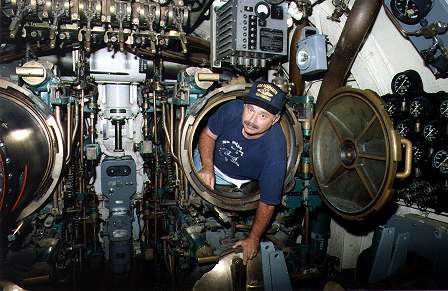

INSIDE A TORPEDO TUBE

FORWARD ENGINE ROOM
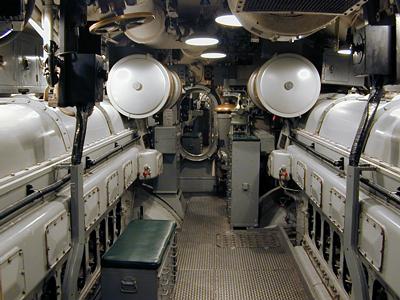
AFT ENGINE ROOM
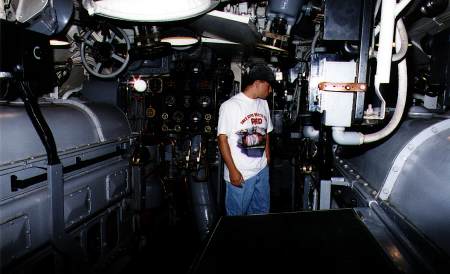
CONTROL ROOM
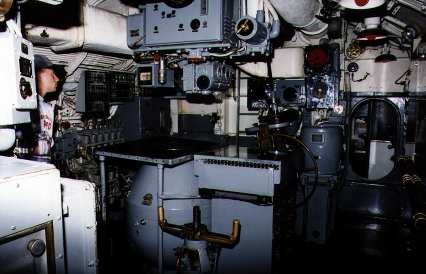
RAL - RAK RECEIVERS
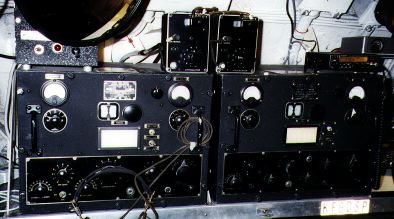
PORTSIDE LONGWIRE
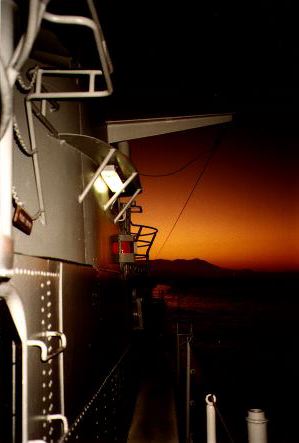
CONNING TOWER
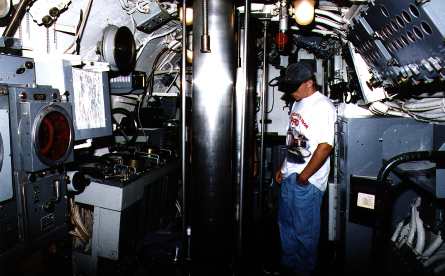
GQ - COLLISION and DIVE ALARMS
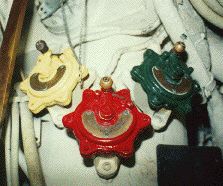
GALLEY SPACE

SIGABA CODING MACHINE
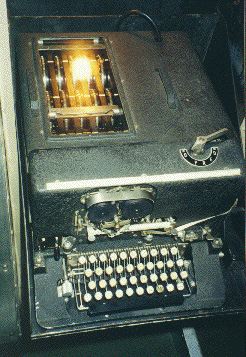
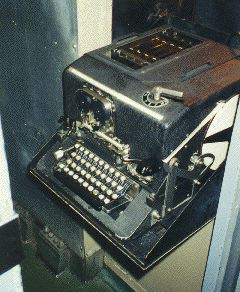
CREW BUNK ROOM
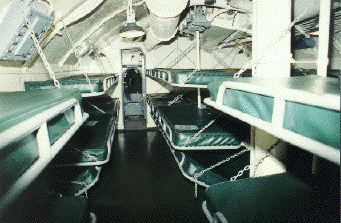
AFT TORPEDO ROOM

CONNING TOWER - STARBOARD SIDE
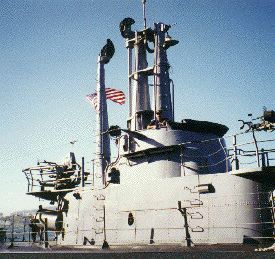
PAMPANITO & SUNSET

RADIO ROOM OPERATOR POSITION
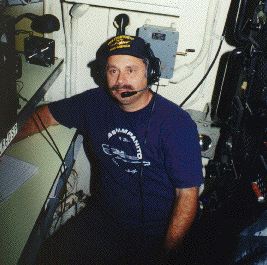
RADIO ROOM
RAL-6 receiver, manufactured by RCA in 1943, freq: .3 Mc to 23 Mc.
RAK-6 receiver, manufactured by ANDREA Radio Corp. in 1943, freq: 15 kc to 600 kc.
To the right of the RAK-6 is the Yaesu FT-890 amateur transceiver, 30 KHz to 30 MHZ, 100 watts.
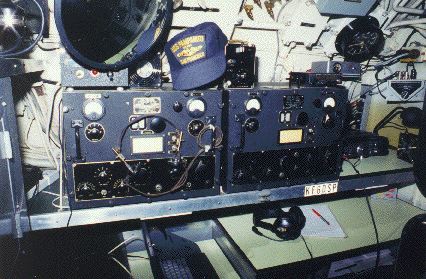
TBL-7 TRANSMITTER
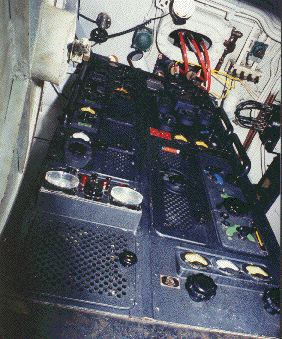
This TBL-7 transmitter was manufactured by Westinghouse Electric & Manufacturing Co. Baltimore, MD., in 1942.
Output: 50 watts AM phone (A3), and 200 watts CW (A1), on 175 to 600 kc and 2000 to 18,100 kc, 100 watts MCW (A2), on 175 to 600 kc. Tubes used are 860's. Weight is 804 pounds.
RADIO ROOM SUPPLY HATCH
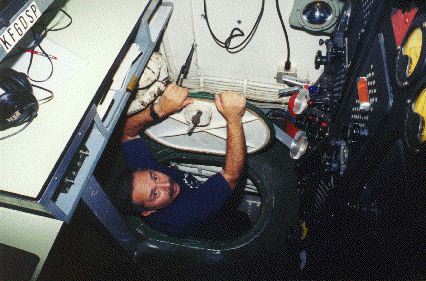
The power supply and battery that is used for the Yaesu FT-890 is kept down in this space. On the right side of the photo is the old WWII TBL-7 transmitter.
USS Pampanito - Dry Dock
January 1999 Dry Docking of the USS Pampanito

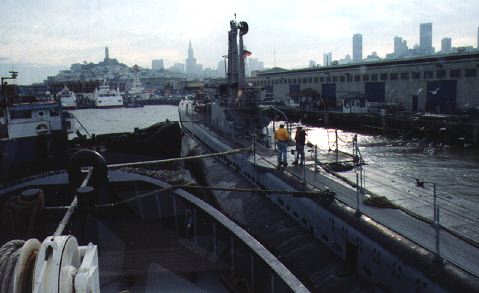

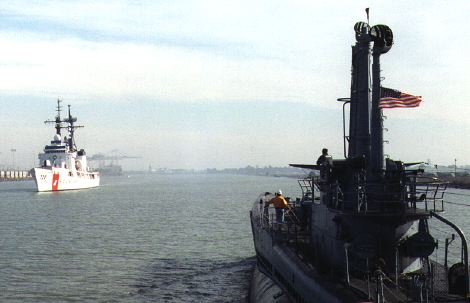
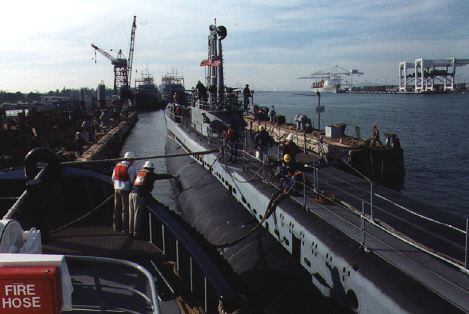
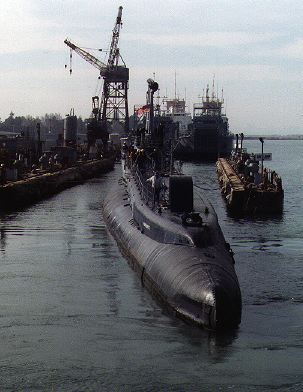
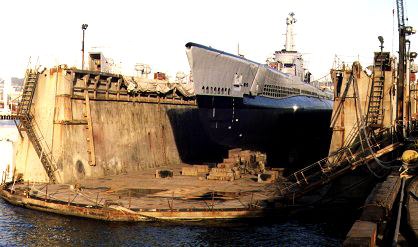
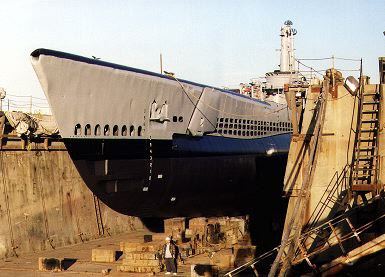
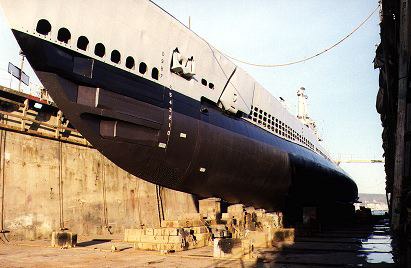
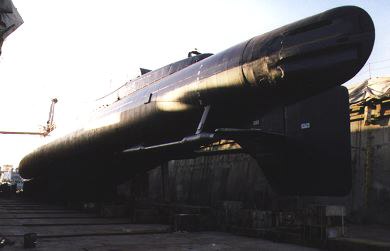
Back to the K6DF Home Page.